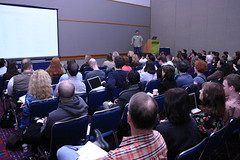 In my Web Application Page Hierarchy talk at WebVisions 2007 I discussed how we use the Web and why understanding how we make sense of what we see allows us to create Web applications that communicate what they do, how to use them, and why people should care to try.
In my Web Application Page Hierarchy talk at WebVisions 2007 I discussed how we use the Web and why understanding how we make sense of what we see allows us to create Web applications that communicate what they do, how to use them, and why people should care to try.
The introduction includes some basic gestalt theory (which may be a review for some people) while the bulk of the talk walks through numerous before and after designs, redesign processes, and more to highlight how the principles behind visual communication (that govern how we see and therefore use the Web) can be used to effectively convey messages, outline actions, organize information, and structure data.
My slides from the talk: Web Application Page Hierarchy (4.2 MB PDF)
Notes from others:
- Web Visions: Presentation Page Hierarchy -Vibrant Journey
- web application hierarchy, after lunch -emergency weblog
From the official description
When a potential customer makes it to one of your Web application's pages, what will they do? Do you want them to sign up, contribute their knowledge, make a purchase, dive deeper into your content? Clearly, these are decisions you don't want to leave up to chance.
In this session, Luke will outline the way people naturally scan Web pages and explain how you can guide users through key content and actions using visual hierarchy to construct meaningful, prioritized page layouts. You'll be taken through several before and after examples with explanations of how a page's content was prioritized, why, and how that priority is being communicated to users so they don't need to rely on chance to use your Web application.